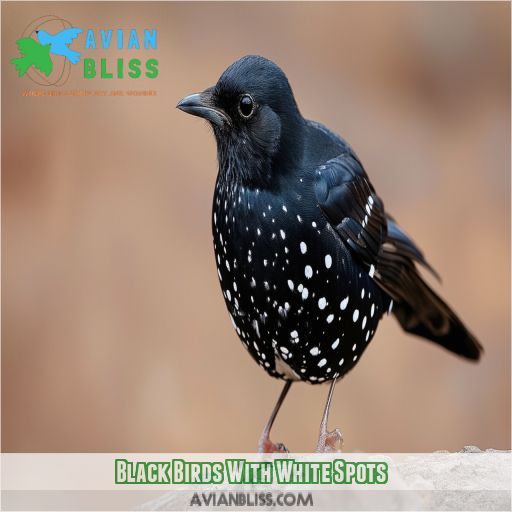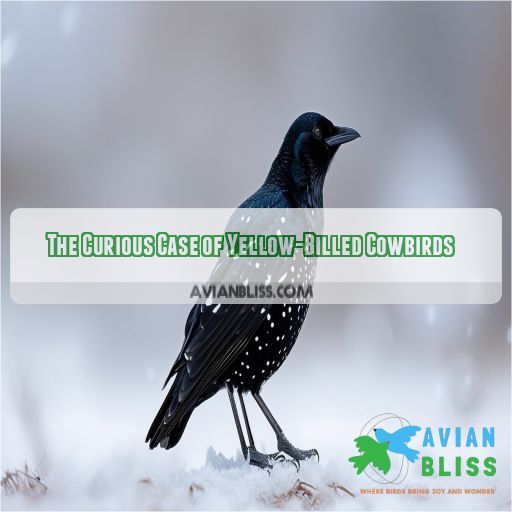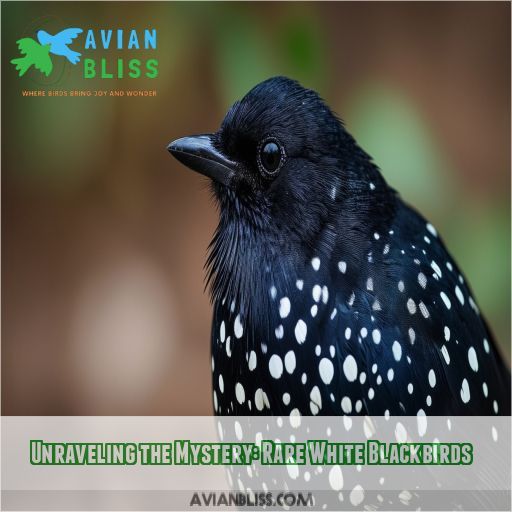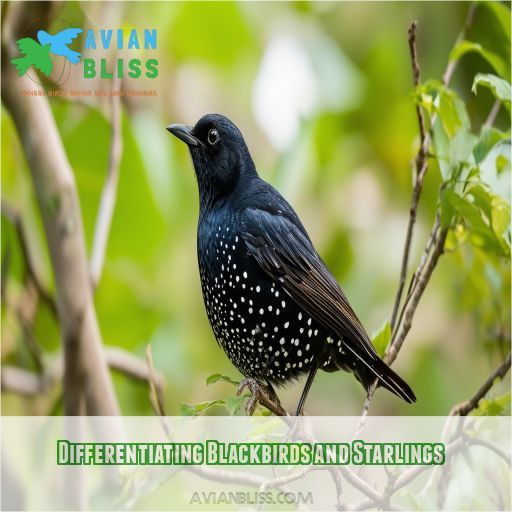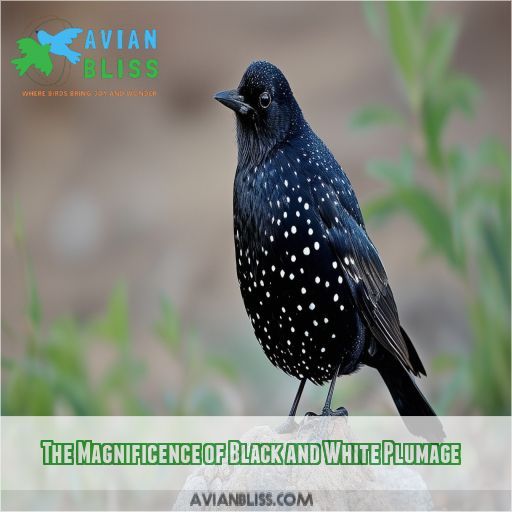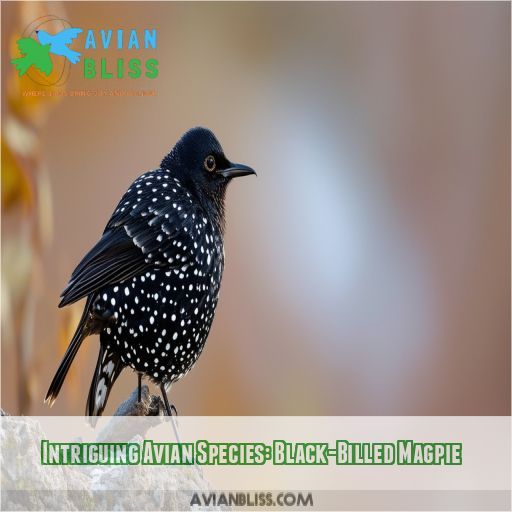This site is supported by our readers. We may earn a commission, at no cost to you, if you purchase through links.
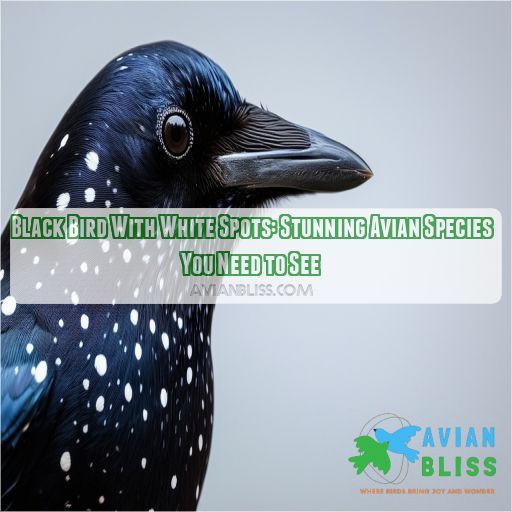 Discover the alluring world of black birds adorned with white spots, nature’s exquisite avian masterpieces. You’ll encounter species that defy norms, from the astute black-billed magpie to the elusive white blackbird. These birds exhibit nature’s artistry, with contrasting plumage that demands attention.
Discover the alluring world of black birds adorned with white spots, nature’s exquisite avian masterpieces. You’ll encounter species that defy norms, from the astute black-billed magpie to the elusive white blackbird. These birds exhibit nature’s artistry, with contrasting plumage that demands attention.
As you explore their diverse habitats and behaviors, you’ll gain proficiency in identifying these unique creatures. Unravel the enigmas behind their striking appearances and learn how to spot these feathered wonders in your own backyard or on your next birdwatching adventure.
Table Of Contents
- Key Takeaways
- Black Birds With White Spots
- Species Spotlight: Black-Billed Magpie
- The Curious Case of Yellow-Billed Cowbirds
- Unraveling the Mystery: Rare White Blackbirds
- Differentiating Blackbirds and Starlings
- Allure of Contrast: Avian Species With Artful Wing Markings
- Conservation Status of Black and White Winged Birds
- The Magnificence of Black and White Plumage
- Intriguing Avian Species: Black-Billed Magpie
- Diverse Birds With Striking Plumage
- Frequently Asked Questions (FAQs)
- What birds are black with white spots?
- Do cowbirds have yellow beaks?
- How rare is a white blackbird?
- Are blackbirds and starlings the same?
- How do black birds with white spots communicate?
- What predators target these birds in their habitats?
- How long do black birds with white spots typically live?
- Do these birds migrate seasonally? If so, where?
- What role do they play in local ecosystems?
- Conclusion
Key Takeaways
- Nature’s tuxedo-clad showstoppers: From the clever magpie to the elusive white blackbird, these dapper birds are like the James Bonds of the avian world – stylish, mysterious, and always catching your eye!
- A bird-watcher’s dream (or nightmare?): Telling apart starlings, cowbirds, and blackbirds might drive you cuckoo, but mastering these subtle differences will make you the Sherlock Holmes of your local park.
- More than just a pretty face: These spotted beauties play crucial roles in their ecosystems, from pest control to seed dispersal. They’re not just eye candy – they’re nature’s little multitaskers!
- Conservation is key: Keep your eyes peeled for these feathered friends, as some face habitat loss and other challenges. Your backyard could become a five-star bird resort with a little TLC!
Black Birds With White Spots
You’ve spotted a black bird with white spots, and your curiosity’s piqued, possibly due to a rare case of bird leucism. These striking creatures often leave birdwatchers puzzled, but fear not! We’ll help you crack the code of blackbird identification. While many species sport this plumage pattern, each has its unique charm.
European Starlings, for instance, dazzle with their white-spotted winter coats, while Magpies boast bold white patches on their wings and undersides. Don’t let Cowbird confusion cloud your judgment; they’re brown, not black!
As you marvel at these feathered beauties, remember that some face conservation concerns. Your keen eye might just help protect them.
Species Spotlight: Black-Billed Magpie
Transitioning from the diverse realm of black birds with white spots, let’s focus on a remarkable species that epitomizes this striking contrast: the black-billed magpie. You’ll encounter this intelligent bird strutting through open woodlands and meadows, its long tail bobbing as it goes. With its glossy black plumage adorned with brilliant white belly and wings, it’s a sight to behold.
Don’t let its beauty deceive you – magpies are cunning survivors. Their diet is as varied as their vocalizations, ranging from insects to small mammals and even carrion. You’ll hear their raucous calls echoing through their habitat, a complex repertoire that hints at their remarkable intelligence.
These birds have been observed using tools and even recognizing themselves in mirrors! As you explore the world of black and white birds, the black-billed magpie stands out as a true master of adaptation and survival.
The Curious Case of Yellow-Billed Cowbirds
While magpies captivate with their striking plumage, another bird demands your attention: the yellow-billed cowbird. This species stands out due to its unique breeding strategy and distinctive appearance. You’ll find these birds fascinating for several reasons:
- Brood parasitism: They lay eggs in other birds’ nests.
- Range expansion: Their territory has grown considerably.
- Distinctive coloration: Males sport glossy black feathers with contrasting yellow bills.
Cowbirds’ parasitic behavior has led to population declines in some host species. However, recent studies show a decline in cowbird numbers too. The contrast between their dark plumage and yellow bill is due to melanin distribution in their feathers. This black and white bird coloration serves multiple purposes, including camouflage and mate attraction. As you observe these birds, you’ll notice how their appearance helps them blend in with other blackbirds while still maintaining a unique identity.
Unraveling the Mystery: Rare White Blackbirds
While yellow-billed cowbirds might catch your eye, there’s an even rarer sight that’ll make you do a double-take: white blackbirds. These elusive avian anomalies are the stuff of birding legend, often absent from standard field guides. You might think you’re seeing things when a white-spotted blackbird crosses your path, but rest assured, you’re not going crazy.
These unique specimens are the result of genetic variations, creating a stunning contrast to their typically dark-feathered cousins. Their physical characteristics are truly one-of-a-kind, with white patches scattered across their otherwise black plumage.
Spotting one of these rare beauties is like winning the birding lottery – a moment that’ll have you reaching for your camera faster than you can say "avian oddity." So keep your eyes peeled; you never know when you might unravel the mystery of these ghostly blackbirds.
Differentiating Blackbirds and Starlings
Regarding the identification of black birds, you may encounter confusion due to the similarities between blackbirds and starlings. Here are some distinguishing features:
- Size: Blackbirds are generally larger, with a more robust build compared to the sleeker starlings.
- Bill shape: Starlings have longer, pointier bills, while blackbirds sport shorter, thicker beaks.
- Plumage: Starlings have a glossy, iridescent sheen with white spots, whereas blackbirds are more uniformly black.
- Behavior: Starlings often move in large, coordinated flocks, while blackbirds tend to be more solitary or in smaller groups.
Their habitats and vocalizations also differ. Blackbirds prefer open fields and marshes, while starlings thrive in urban areas. Listen for the melodious song of blackbirds versus the varied, mimicking calls of starlings. By mastering these distinctions, you’ll soon be able to confidently identify these fascinating black birds, along with other species like the black-billed cuckoo or black skimmer.
Allure of Contrast: Avian Species With Artful Wing Markings
You’ll find the allure of contrast in several avian species with artful wing markings, including the Magpie (Pica pica), Black-and-White Warbler (Mniotilta varia), and Eurasian Oystercatcher (Haematopus ostralegus). These birds showcase striking black and white patterns on their wings, creating a visual spectacle that’s both aesthetically pleasing and functionally significant in their respective habitats.
Magpie (Pica Pica)
Unlike starlings, magpies boast striking black and white plumage. You’ll find these clever corvids in a variety of habitats, from woodlands to urban areas. Their omnivorous diet and adaptable behavior contribute to their success. With a lifespan of up to 15 years, magpies have ample time to display their intelligence.
Black-and-White Warbler (Mniotilta Varia)
You’ll be captivated by the Black-and-White Warbler’s striking plumage. This small songbird’s unique vertical climbing habit sets it apart from other warblers. Its black uppersides and white stripes create a mesmerizing contrast, often confusing novice birders who mistake it for a nuthatch or woodpecker. Conservation efforts are essential for its survival.
Eurasian Oystercatcher (Haematopus Ostralegus)
Unlike the elusive warbler, you’ll easily spot the Eurasian oystercatcher‘s striking black-and-white plumage. This coastal dweller’s bold contrast isn’t just for show; it’s critical for survival. Their unique appearance helps them blend in rocky shores and alerts predators to their formidable bills. Conservation efforts are essential for protecting these iconic birds.
Conservation Status of Black and White Winged Birds
As you explore the realm of black and white winged birds, it’s essential to comprehend their conservation status. Many of these stunning species face significant challenges in today’s evolving environment. You’ll find that habitat loss, climate change, and human activities pose serious threats to their survival.
To grasp the intricacy of their situation, consider these key points:
- Population decline: Species like the mute swan and wood stork have experienced concerning drops in numbers.
- Habitat conservation: Protecting wetlands is pivotal for white pelicans and American coots.
- Species protection: Strict regulations are necessary to safeguard vulnerable birds like the common loon.
- Conservation challenges: Balancing human development with avian habitat needs remains an ongoing struggle.
The Magnificence of Black and White Plumage
You’ll find the Black Skimmer, Black Phoebe, and Black-Necked Stilt to be striking examples of birds with black and white plumage. These species showcase nature’s artistry through their bold contrasts, with the Black Skimmer’s unique bill, the Black Phoebe’s crisp markings, and the Black-Necked Stilt’s long, slender legs adding to their visual appeal.
Black Skimmer (Rynchops Niger)
You’ll be captivated by the Black Skimmer‘s unique appearance and behavior. With its striking black and white plumage, this bird’s most distinguishing feature is its unusual bill. Watch in awe as it skims the water’s surface, using its elongated lower mandible to snatch fish with precision.
Black Phoebe (Sayornis Nigricans)
Moving from the Black Skimmer, let’s explore the Black Phoebe. This striking bird’s habitat ranges from streams to urban areas. Its diet consists mainly of insects, which it catches mid-air. During mating season, you’ll find them building mud nests under bridges or eaves. Conservation efforts focus on preserving their diverse habitats.
Black-Necked Stilt (Himantopus Mexicanus)
You’ll be captivated by the Black-Necked Stilt’s striking appearance. These long-legged waders boast a bold black-and-white plumage that’s hard to miss. Found in shallow wetlands, they’re masters of their domain. Watch them gracefully feed, breed, and defend their territory with unmatched elegance and precision.
Intriguing Avian Species: Black-Billed Magpie
You’ll find the Spotted Towhee, Atlantic Puffin, and Eastern Towhee among the most alluring black birds with white spots. These species showcase unique plumage patterns that set them apart.
The Spotted Towhee features black and white speckled wings, the Atlantic Puffin displays distinctive black and white face markings, and the Eastern Towhee exhibits bold black and white contrast on its sides and wings.
Spotted Towhee (Pipilo Maculatus)
You’ll be captivated by the Spotted Towhee’s striking appearance. With its jet-black upper parts and vibrant white spots, this bird’s a master of contrast. Don’t be fooled by its Juvenile Plumage or Winter Plumage variations. Listen closely for its impressive Vocal Imitations, and explore its diverse Habitat Preferences.
Atlantic Puffin (Fratercula Arctica)
You’ll find Atlantic Puffins in coastal habitats, diving for fish with their distinctive beaks. During breeding season, they nest in burrows on cliff edges. While not black with white spots, their tuxedo-like plumage and colorful bills make them unforgettable. Conservation efforts are essential for these charismatic seabirds.
Eastern Towhee (Pipilo Erythrophthalmus)
Moving from puffins to land, you’ll find the Eastern Towhee, a striking bird with black and white plumage. This ground-dwelling species shares similarities with its western cousin, Pipilo maculatus. Eastern Towhees captivate with their:
- Distinctive "drink-your-tea" call
- Energetic scratching for food
- Preference for dense undergrowth habitats
Diverse Birds With Striking Plumage
Moving beyond the Black-Billed Magpie, you’ll discover a world of birds with equally striking plumage**. Nature’s palette offers an array of species that’ll captivate your senses and challenge your bird-watching skills.
From the bold Blackbird plumage to the intricate Magpie markings, these avian wonders showcase nature’s artistry. You might stumble upon the Yellow-billed Magpie, its identity a puzzle for novice birders. Or perhaps you’ll witness the rare sight of a White Blackbird, a genetic anomaly that’ll make your heart race.
The black and white wing contrasts of various species create a visual spectacle that’s hard to ignore. As you explore this diverse world of feathered creatures, you’ll gain a deeper appreciation for the complexity and beauty of avian evolution.
Each sighting becomes a small victory, a step toward mastering the art of bird identification.
Frequently Asked Questions (FAQs)
What birds are black with white spots?
Like stars scattered across a midnight sky, several birds don white-spotted plumage. You’ll find European Starlings, Common Grackles, and Spotted Nutcrackers among these avian gems. Their distinctive markings serve both camouflage and communication purposes in their diverse habitats.
Do cowbirds have yellow beaks?
No, cowbirds don’t have yellow beaks. You’ll notice their bills are short, thick, and typically dark-colored. This distinguishing feature sets them apart from starlings, which do sport yellow beaks during certain seasons. Keep an eye out for these differences!
How rare is a white blackbird?
White blackbirds, a rare genetic mutation, occur in about 1 in 20,000 birds. You’ll rarely spot one in the wild. They’re leucistic, not albino, retaining dark eyes. This unique coloration makes them stand out among their peers.
Are blackbirds and starlings the same?
No, blackbirds and starlings aren’t the same. You’ll notice distinct differences: starlings have glossy plumage with white spots, while blackbirds are solid black. Starlings are expert mimics and flock in large numbers, unlike their solitary blackbird cousins.
How do black birds with white spots communicate?
Like a symphony orchestra, birds communicate through diverse vocalizations. You’ll hear their songs, calls, and mimicry. They also use visual cues, displaying feathers or performing rituals. Their body language conveys messages, from aggression to courtship.
What predators target these birds in their habitats?
Hawks, falcons, and owls prey on these birds, swooping from above. Cats, snakes, and raccoons pose threats on the ground. You’ll find their predators vary by habitat, with urban areas introducing new dangers like windows and vehicles.
How long do black birds with white spots typically live?
You’ll find that most starlings live around 2-3 years in the wild, though they can reach up to 15 years with luck. Their lifespan’s influenced by predators, habitat quality, and food availability. Don’t be surprised if they outlive expectations!
Do these birds migrate seasonally? If so, where?
You’ll find these birds are partial migrants. They’ll often stay put in urban areas with reliable food sources year-round. However, northern populations typically move south for winter, seeking warmer climates and better foraging opportunities.
What role do they play in local ecosystems?
You’ll find these birds playing essential roles in local ecosystems. They’re nature’s pest controllers, devouring insects and grubs. They’re also seed dispersers, helping plants spread. Their droppings fertilize soil, and they’re prey for larger predators, supporting biodiversity.
Conclusion
From the mysterious white blackbird to the striking black-billed magpie, you’ve begun your adventure through the enchanting realm of black birds with white spots. You’ve witnessed the artistry of nature in their contrasting plumage and learned to distinguish between similar species.
As you continue your birdwatching escapades, you’ll now be equipped to recognize these unique avian treasures. Remember, these birds aren’t just aesthetically pleasing; they play a crucial role in their ecosystems.
Continue exploring, observing, and appreciating the diverse and stunning black birds with white spots in your surroundings.

